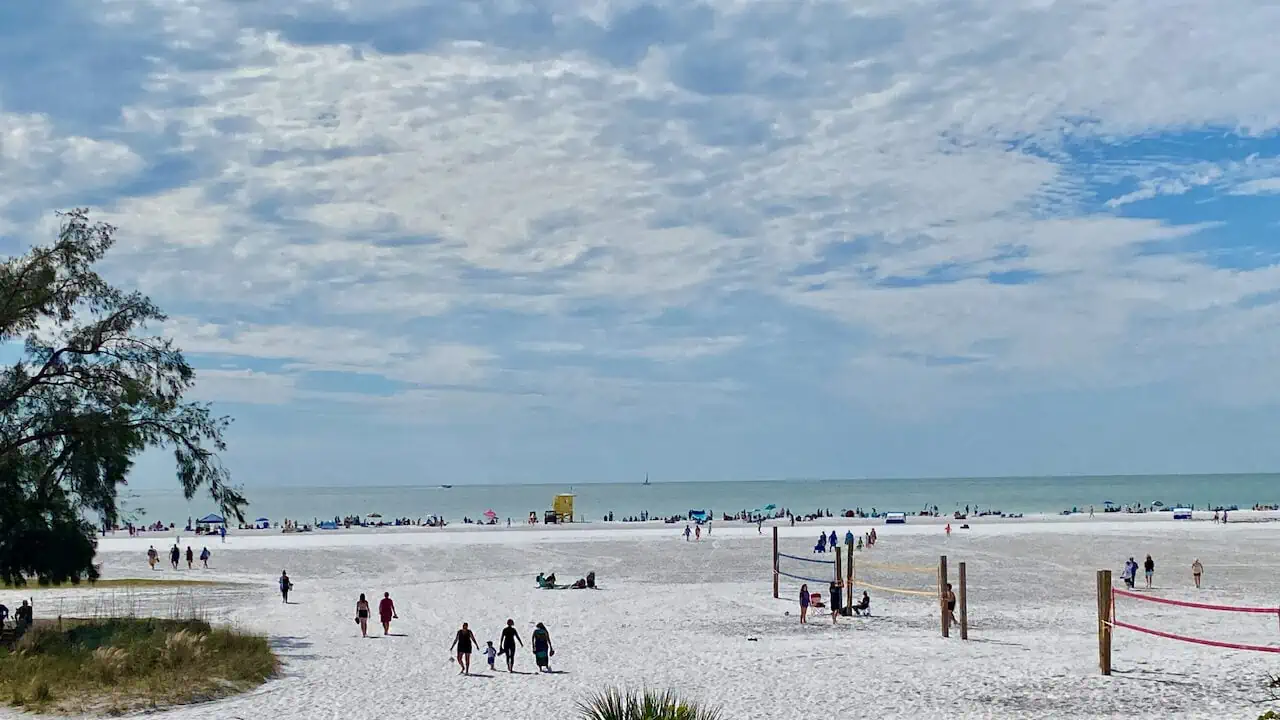Table of Contents
Have you ever wondered what the odds are of encountering sharks in Siesta Key? I’ll give you a bit of a spoiler for this article and tell you that it’s pretty rare!
Siesta Key is one of my favorite places in Florida, and it’s home to one of my top favorite clear water beaches, Siesta Beach. Also known as Siesta Key Public Beach, this beach is hard to beat unless you’re on a boat!
The white sand is made of fine, sugar-soft quartz and the water is shallow ideal for families. All that natural beauty plus abundant amenities like playgrounds, concessions, and free parking are the formula for a perfect beach day. Plus, Siesta Key Village, one of my favorite laid-back spots to grab a bite to eat is nearby.
The risk of running into a shark can sometimes discourage people from going to Gulf Coast beaches. This is especially the case for Florida beaches, where shark encounters are most common.
There are indeed sharks in Florida’s water but unprovoked shark attacks are very uncommon in Sarasota County. However, you should always practice proper beach safety to keep yourself (and especially your kids) safe.
Let’s get into the Siesta Key shark attack statistics. I’ll also share a list of the most common shark species near Siesta Key, as well as a short guide on safety advice for swimmers. Equipped with the knowledge in this article, and putting that safety advice into practice, you’ll be good to go to enjoy your Siesta Key vacation!
Shark Attacks in Siesta Key
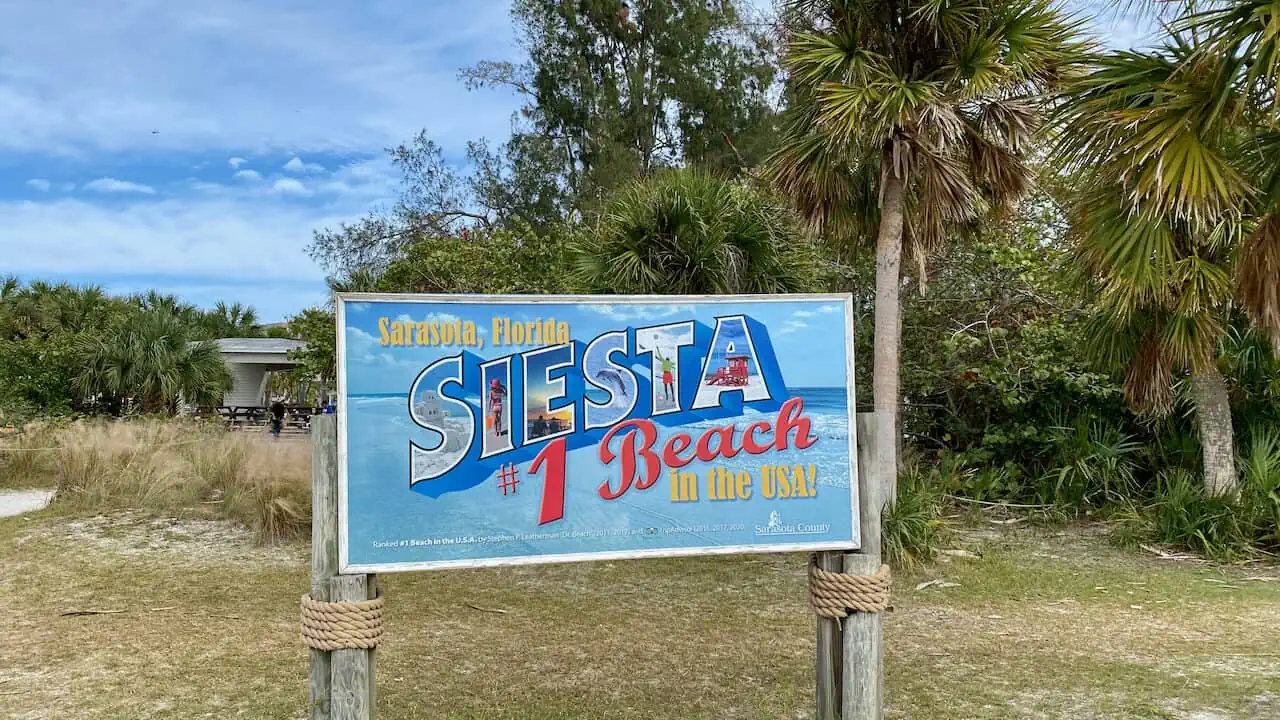
Shark attacks in Siesta Key are few and far between — rare enough that you’re more likely to be struck by lightning at the beach than get bitten by a shark.
The main thing that deters sharks is following proper beach safety precautions. There have, however, been a couple of shark attacks in Siesta Key in the past few decades. So it’s important to follow safety precautions by life guards and the local authorities.
Florida Shark Attacks by County
The United States is the shark capital of the world, accounting for 41 out of 57 unprovoked shark bites worldwide in 2022. The biggest contributor is actually Florida. In 2022, Florida was the US state with the most unprovoked shark attacks, 16 out of 41.
These numbers come from the University of Florida, which also has a breakdown of unprovoked shark attacks across counties in Florida since 1882.
Looking at the table below, you’ll be relieved to see that Sarasota County (where Siesta Key is located) is pretty low on the list. There have been just 7 unprovoked shark attacks here since 1882. Compare that to Volusia County and Brevard County with 343 and 156 recorded attacks, respectively.
| County | Total |
|---|---|
| Volusia | 343 |
| Brevard | 156 |
| Palm Beach | 82 |
| St. Johns | 45 |
| Duval | 46 |
| Martin | 41 |
| St. Lucie | 37 |
| Indian River | 22 |
| Monroe | 21 |
| Miami-Dade | 19 |
| Broward | 16 |
| Pinellas | 14 |
| Bay | 9 |
| Collier | 8 |
| Lee | 8 |
| Sarasota | 7 |
| Flagler | 6 |
| Escambia | 6 |
| Nassau | 8 |
| Okaloosa | 4 |
| Manatee | 5 |
| Gulf | 2 |
| Franklin | 2 |
| Walton | 1 |
| Charlotte | 1 |
| Santa Rosa | 1 |
Shark Attacks in Siesta Key
The most recent unprovoked Siesta Key shark attack was in December 2020. A man was bitten on his arm and hand while swimming off Siesta Key. It was a non-fatal injury, and it’s unclear what kind of shark bit him.
A much scarier incident happened in Sarasota Bay in August 2007. A woman was swimming at night along with a small group of friends and a small boat. No lights were on, as they were looking for bioluminescent algae. What’s estimated to have been a bull shark bit her, and she had to get more than 100 stitches.
Another Siesta Shark attack incident was in July 1996. A woman had her foot bitten by a shark while at Siesta Key Public Beach during the middle of the day. It’s unknown what kind of shark bit her.
Species of Sharks in Sarasota Bay and Siesta Key
There are a few shark species that live in Sarasota Bay, though they typically stay in the deeper areas. Most shark species found in the Gulf of Mexico prefer to be far out at sea.
When the red tide occurs, shark sightings become more common, as sharks come further into the Sarasota Bay and its estuaries than usual.
Under normal conditions, however, most sharks prefer not to stay in shallow water. This is good news for potential Siesta Key beachgoers, as the water all around is quite shallow.
Some most common species of sharks in Sarasota Bay and Siesta Key include Blacktip Sharks, Hammerhead Sharks, Nurse Sharks, and Lemon Sharks.
🌴 Related: Siesta Key vs Anna Maria: Which is Best?
Blacktip Sharks
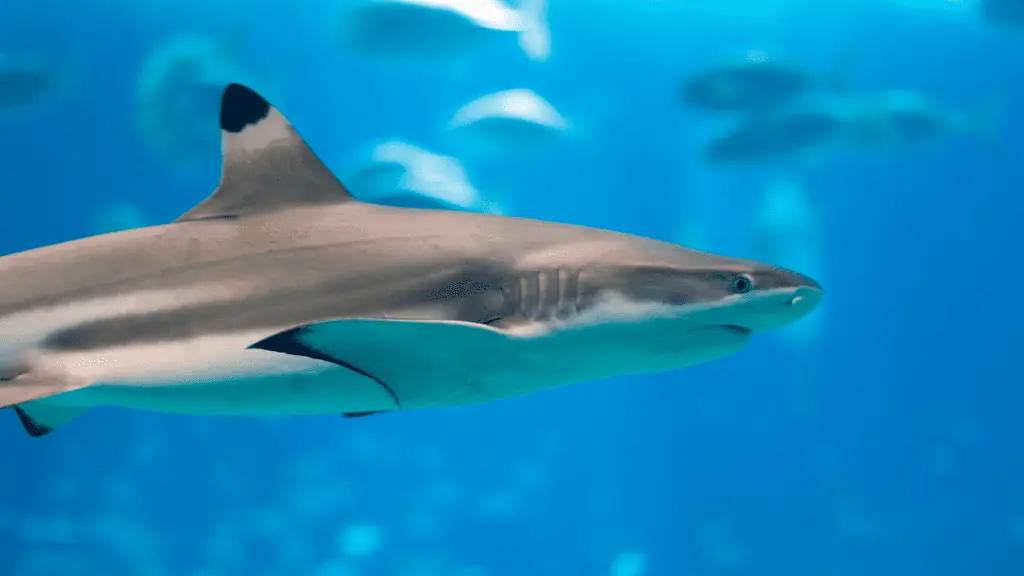
The blacktip shark is one of the most common sharks in Siesta Key and the greater Sarasota area. They’re estimated to be the most common shark implicated in cases of unprovoked shark bites, though it and related species are easy to confuse.
Young blacktip sharks are most likely to be encountered in shallow waters near the beach. Adult blacktip sharks typically only come around during the winter. Adults’ average length is around 5 to 6 feet, but they can grow as long as 8 feet.
Blacktip sharks have a streamlined, bluish-gray body and a pointed snout. Their most noticeable features are, of course, the black tips on their fins.
Hammerhead Sharks
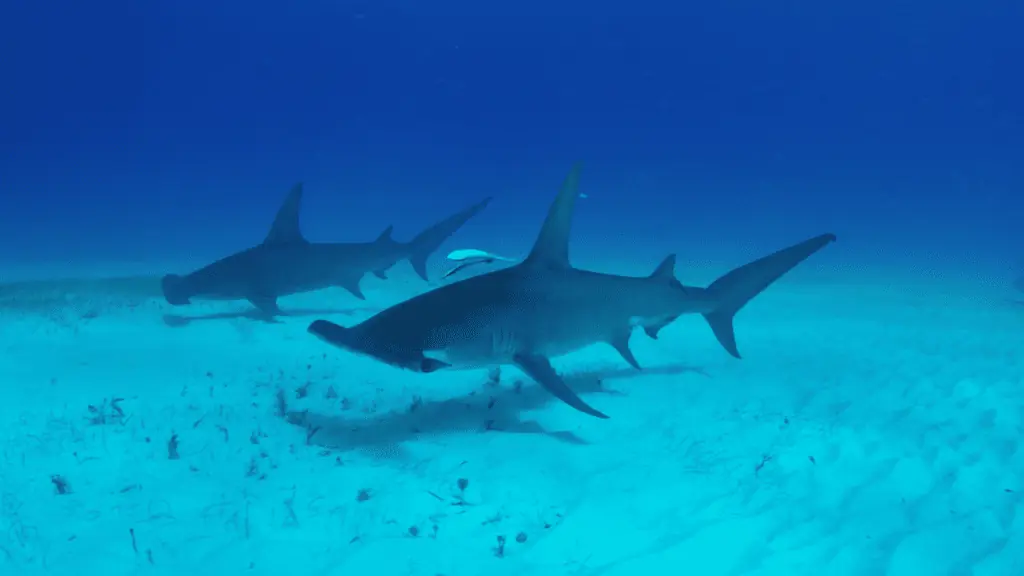
If you see a hammerhead shark around Siesta Key, it’ll probably be either a bonnethead shark or a scalloped hammerhead shark.
Bonnethead sharks are smaller, growing around 3 to 4 feet in length. They are easily recognizable by their shovel-shaped heads. These sharks are commonly found in shallow bay water but they are generally harmless to humans.
Scalloped hammerhead sharks’ heads have that distinctive, flat “hammerhead” look. They are also bigger, usually around 5 feet long but can be even larger. These sharks sometimes get confused with great hammerhead sharks, but the latter are much larger and are more common in South Florida.
Nurse Sharks

You can recognize nurse sharks by their catfish-like whiskers and yellowish-tan body. These sharks are sometimes seen in Sarasota but are more common in South Florida. They are bottom-dwellers but will occasionally rest in shallow water, such as areas with mangroves.
Though they’re quite large (7.5 to 8 feet long on average), nurse sharks aren’t aggressive and are rarely ever involved in shark attacks. When they are involved, it’s usually due to being provoked by humans.
Lemon Sharks
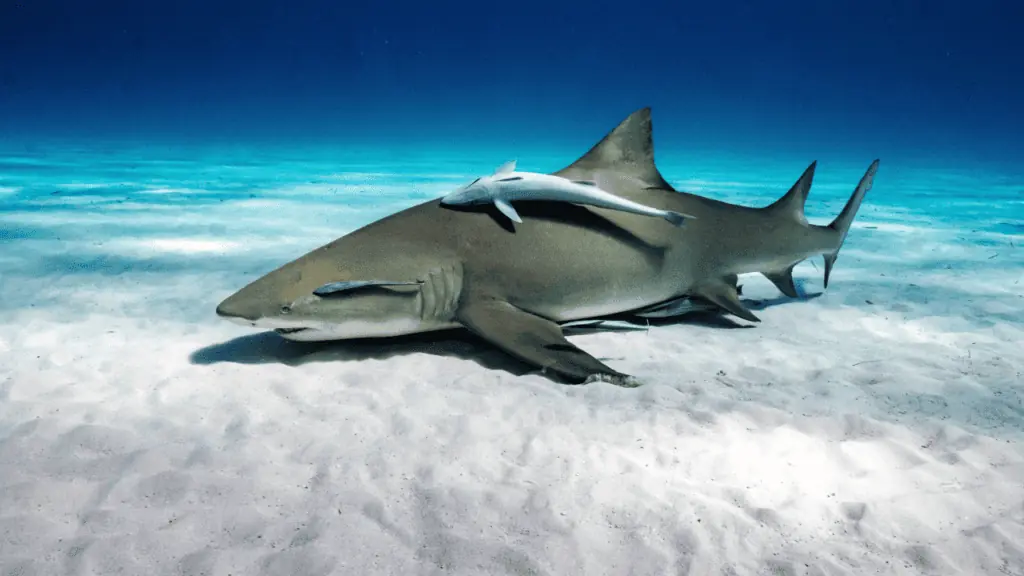
Lemon sharks get their name, unsurprisingly, from their yellow-tinted body. You can also recognize them by their equally-sized dorsal fins.
Similarly to nurse sharks, lemon sharks grow to a hefty 8 to 10 feet long on average but they’re generally not dangerous. They’re typically calm but become aggressive when provoked.
There are quite a few other shark species that are found in the Gulf of Mexico that might be found near Siesta Key. These include tiger sharks and blacknose sharks. They’re less common, though. Bull sharks are very rare but have been blamed for shark attacks in the area before.
Safety Advice for Swimmers
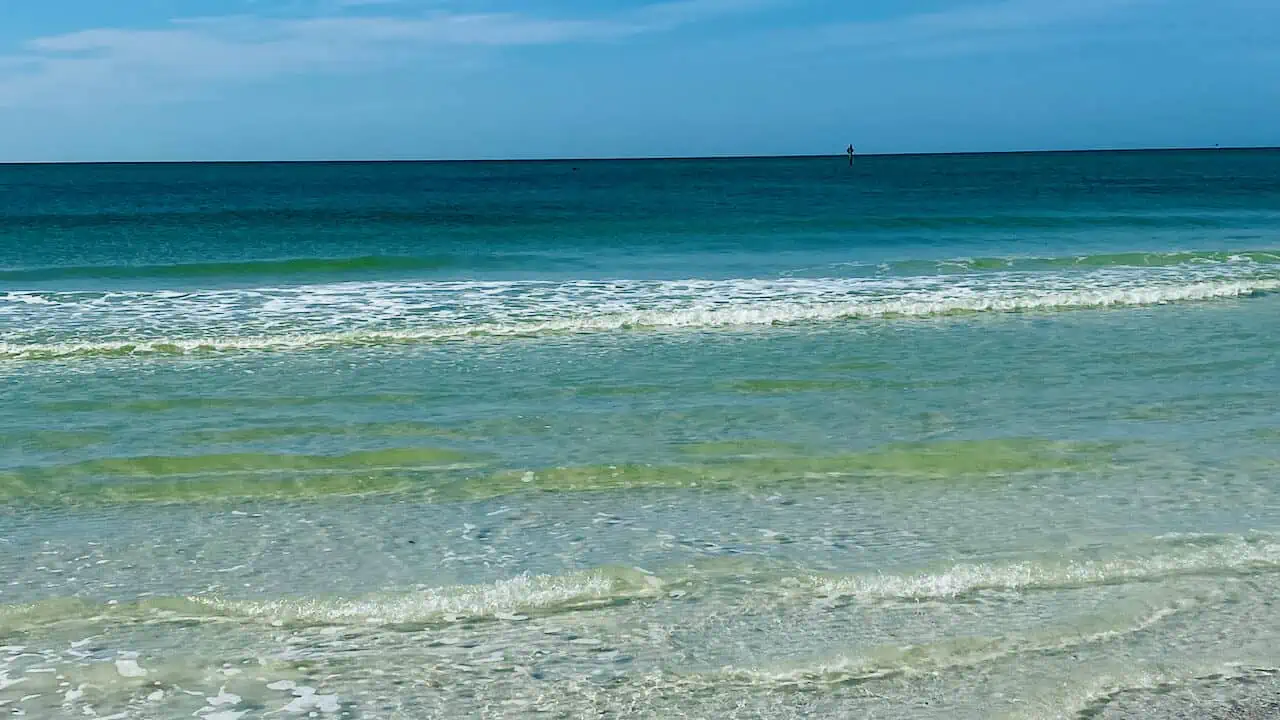
The most surefire way to avoid a shark bite is to follow the recommended beach safety advice. Even in areas like Siesta Key where shark attacks are rare, following precautions only serves to lower the chances even further.
Three main things to keep in mind are the flag warnings, listening to lifeguards, and following good beachgoer safety tips.
Flag Warnings
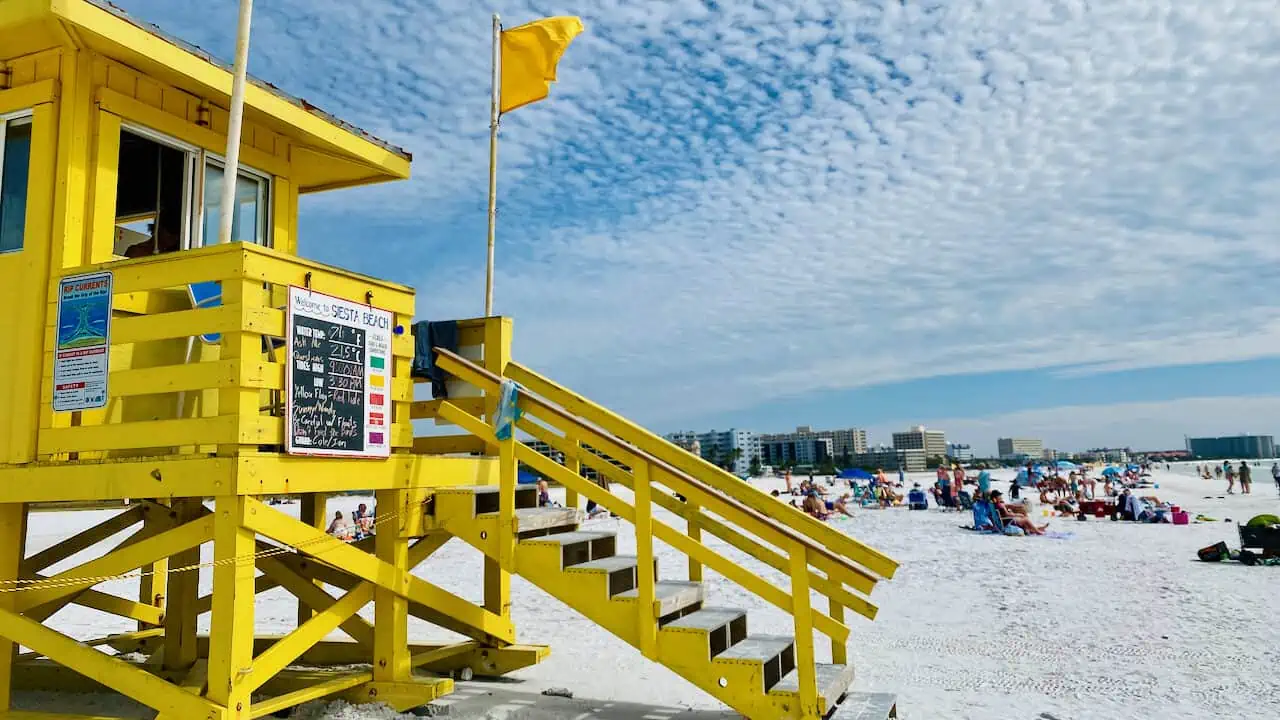
Most beaches in Florida use a flag warning system to easily inform beachgoers of what conditions are like at the beach. This includes beaches on Siesta Key. Before you get into the water, keep your eye out for the various flags and what they stand for:
- Green: calm conditions (good for swimming)
- Yellow: moderate surf and/or currents (use caution)
- Red: high surf and/or strong currents (dangerous swimming conditions)
- Double red: water closed to the public (no swimming)
- Purple: dangerous marine life
It’s important to not that the absence of a flag doesn’t necessarily mean the water is safe!
Lifeguards
Lifeguards are present all week long at 6 beaches in Sarasota County, including Siesta Key Public Beach on Siesta Key. In fact, Siesta Key Public Beach is known for its four iconic lifeguard stands, painted yellow, red, green, and blue, each.
As much as possible, only swim in lifeguard-protected areas — this especially goes for kids. Also, if you’re ever unsure about anything related to beach conditions or safety, don’t hesitate to ask a lifeguard for help.
In addition to saving swimmers, the lifeguards are trained to keep watch for sightings and signs of sharks. They then notify beachgoers accordingly and do what they can to get the shark back out further in the Gulf.
This kind of thing doesn’t happen often, but there was a noteworthy incident in Siesta Key in June 1998. Two hammerhead sharks were feeding near the beach on a Tarpon, and lifeguards moved their meal further out to reopen Siesta Key Public Beach. Again, the sharks were not attempting to attack humans.
8 Important Tips to Avoid a Shark Attack
So far, I’ve been talking about unprovoked shark attacks. As the name implies, this refers to when you’re bitten by a shark who you didn’t interact with (or at least didn’t knowingly interact with).
These are usually “hit-and-run” bites; the shark bites you once and then leaves right away. One possible cause for this is that it mistook your foot or hand for a fish. This kind of mistake is more common when it’s dark out.
There are, however, provoked shark attacks. These happen when you’ve been purposefully interacting with a shark, whether aggressively or not. The first and most important tip to avoid a shark attack is to NOT interact with sharks — leave them be!
Here are some general and shark-specific safety tips to avoid a shark bite.
- Check the swimming condition flag and do not enter the water if the flag is purple
- Don’t swim when you’re bleeding — it may attract sharks if they’re already nearby.
- Don’t swim at dawn, dusk, and night. This is when sharks tend to be more active; low-light conditions increase your chances of being mistaken for prey.
- Don’t swim close to where people are fishing or feeding fish, as sharks may be lured in.
- Swim with at least one other person at all times; sharks tend to avoid groups of people.
- Don’t venture too far out at sea, as this makes it harder to get lifeguard assistance.
- Take off any shiny jewelry before swimming, as it’s possible for the jewelry to be mistaken for fish scales.
- If a shark is near, avoid excessive splashing that implies distress.
Final Thoughts on Sharks in Siesta Key
In regards to question, are there sharks in Siesta Key? Yes, but they’re rarely venture into the shallow beach waters. Even then, the risk of an unprovoked attack is low, especially if you practice good swimming safety. Despite these things, I never let my guard down when swimming in the Gulf of Mexico.
As mentioned, Siesta Key is home to one of my favorite Florida beaches. Not only is the beach beautiful, but I feel safe there thanks to the lifeguards, pristine beach facilities, and family-friendly environment. Afterward, don’t forget to check out the chill but charming town of Siesta Key Village.
If you’re planning a visit to Siesta Key or Sarasota County, don’t let fear keep you from experiencing the amazing beaches here. Exercise caution, have fun, and enjoy your vacation!
Frequently Asked Questions
Is it safe to swim in Siesta Key?
It is very safe to swim in Siesta Key! The water is usually calm, sharks are rare, and there are lifeguards on duty year-round. Just make sure to heed the beach flag warnings, stay close to lifeguards, and follow beach safety guidelines.
What is the most common shark in Siesta Key?
Blacktip sharks, hammerhead sharks, nurse sharks, and lemon sharks are the most common sharks in Siesta Key and the rest of the area around Sarasota.
Are there jellyfish in Siesta Key Beach?
There are indeed jellyfish around Siesta Key. You can avoid jellyfish by first not going into the water when there is a purple warning flag (indicating dangerous marine life). Also, don’t touch a jellyfish that’s been washed up on the shore — it’s still possible for it to sting you. If you’re stung, go to a lifeguard and they’ll treat it.
Are there great white sharks in Sarasota Florida?
There hasn’t been a confirmed great white sharks in Sarasota in recent years. There was a juvenile great white shark tagged off the nearby shore of Longboat Key in February 2023. While great white sharks are in the Gulf of Mexico, they almost always stay further away from shore.
What is the deadliest beach in Florida for shark attacks?
The deadliest beach is New Smyrna Beach. The East Coast gets the most shark attacks in Florida.

